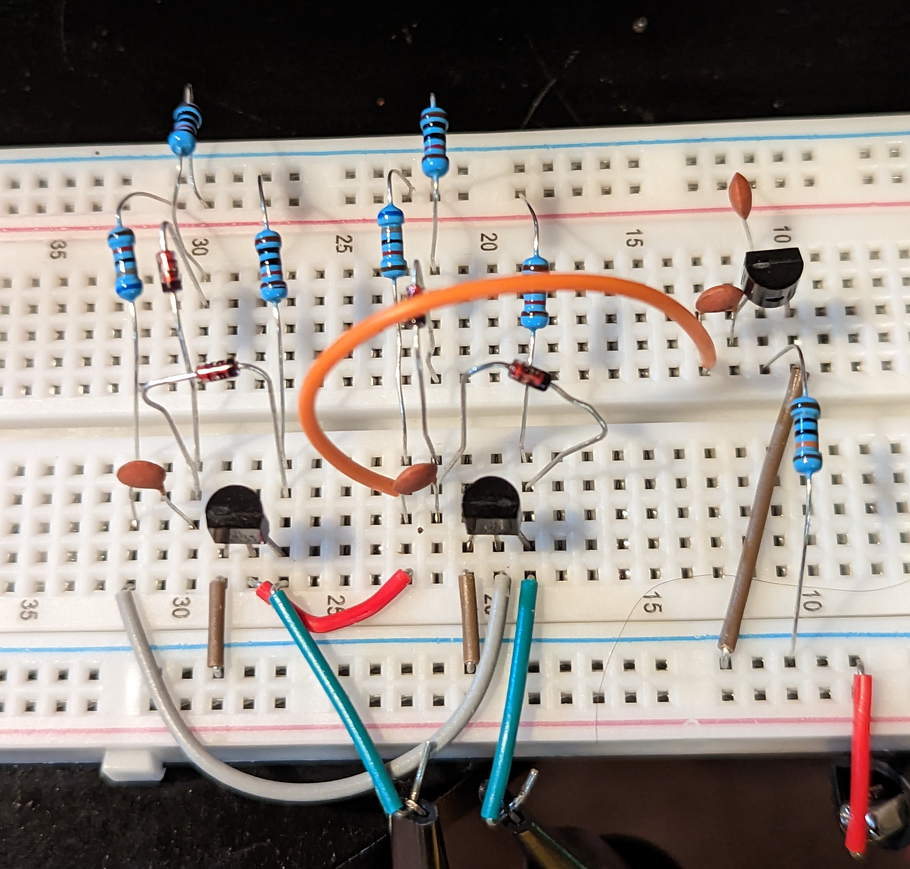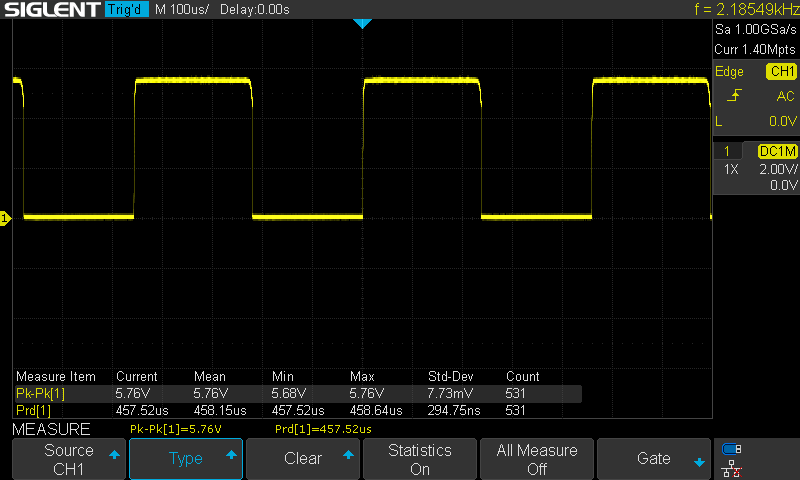Astable Multivibrator 2
I built an “improved” astable multivibrator circuit from:
IMPROVED ASTABLE MULTIVIBRATOR, by RAJU BADDI, National Center for Radio Astrophysics, TIFR, Ganeshkhind P.O Bag 3, Pune University Campus, PUNE 411007, Maharashtra, INDIA; baddi@ncra.tifr.res.in
Here’s the schematic of the improved circuit:

Original astable multivibrator post.
Here’s my breadboarded real circuit:

As per the “TEST VALUES” section of the article, I built the circuit with:
1N4148 diodes
2N3904 transistors
Rc = 10K Ω
Rb = 68K Ω
C = 5 nF, see below
Waveform
I can recreate Baddi’s results closely:

That’s a lot closer to an ideal square wave than my first attempt at an astable multivibrator.
I got the breadboarded circuit to start oscillating at about 1.1 applied volts, which is a little lower than Baddi’s simulated circuit. The waveform is a lot sloppier when it’s just barely oscillating:

The 2N3904 side circuit really does help the main circuit start oscillating. Without it, sometimes the main circuit does not start oscillating on power-up.
It’s not clear from reading the paper that Baddi built the circuit, or just simulated it.
Frequency
Baddi’s equation (1): ton = 0.62RbC = 0.62(68000)(5e-9) = 2.1e-4 seconds
f = 1/(2ton) = 1/(4.2e-4) = 2.4 kHz
That’s at an applied voltage of 5.5V
The frequency of oscillation varied with applied voltage.
| Voltage | Frequency, kHz |
|---|---|
| 1.24 | 4.0 |
| 1.50 | 3.35 |
| 2.03 | 2.71 |
| 2.51 | 2.48 |
| 3.0 | 2.35 |
| 4.0 | 2.2 |
| 5.0 | 2.15 |
| 5.5 | 2.15 |
| 7.0 | 2.18 |
I calculated 2.4 KHz, I measured 2.15 kHz at 5.5V. That’s good agreement with theory.
The behavior is quite different from my first astable multivibrator circuit, where frequency increased with applied voltage.
Alas, I’m not knowledgeable enough to figure this one out.
Components
I used transistors labeled 2N3904 that I got in an assortment from Amazon with the “Bojack” brand name. I don’t have enough knowledge to verify that these transistors fit the 2N3904 spec.
I used diodes labeled 1N4148 from a “Mogaopi” brand diode assortment. They have little glass bead cases, which is typical of 1N4148, I believe, so they’re probably more-or-less right.
All resistors were very close to nominal.
The capacitors were also from a “Mogaopi” brand assortment. I had to find a pair of capacitors that were fairly close. When the capacitors were too unbalanced, the circuit acted weird. It wouldn’t start oscillating, or, when I lowered the voltage until oscillation stopped, it wouldn’t start again.
I had a little bag of nominal 10 nF ceramic capacitors, the packaging did not indicate any kind of tolerance. Not a single one was 10 nF.
| nano Farads |
|---|
| 3.7 |
| 5 |
| 5.3 |
| 5.6 |
| 6.8 |
| 6.9 |
| 7.5 |
| 8.8 |
That’s a lot of variation for nominal 10 nF. Assuming a +/-10% tolerance, every single one was out of spec. At a 20% tolerance, only a single capacitor was within spec. I ended up using the 5 and 5.3 nF capacitors.
